 |
Robug III  Basics
Basicssize: 31" long, 24" wide, 24" high—with eight 39" legs price tag: $1.3 million see me in action Getting Around Engineers at the University of Portsmouth in England looked at crabs and spiders for inspiration when designing Robug. With its low-slung light-weight body, Robug III can step over large obstacles. It can also climb up walls using vacuum gripper feet that work even on rough surfaces like brick. Its eight pneumatically powered legs each have four joints, allowing them to navigate with great flexibility over uneven terrain. Speed: up to 20 feet per minute. Control Robug III is connected to a human operator by a 328-foot umbilical cable. The umbilical cable consists of a compressed air hose (for the pneumatically powered legs), a 240V AC power supply, a communications cable and a video cable. The human operator gives instructions mainly on direction. The robot will figure out its own walking gaits and foot placements. Other Features
back | I'm ready to play Photos: University of Portsmouth. Future Robots | Hazardous Duty | Robo Clips Resources | Transcript | Bomb Squad Home Editor's Picks | Previous Sites | Join Us/E-mail | TV/Web Schedule About NOVA | Teachers | Site Map | Shop | Jobs | Search | To print PBS Online | NOVA Online | WGBH © | Updated November 2000 |
